Color Genetics in Icelandic Sheep
Introduction
I thought I had a pretty good "handle" on Icelandic sheep genetics after poring over Stefania Sveinbjarnardottr-Dignum"s article and info sheets for hours. And I certainly thought I understood it after having studied Stefan Adal Steinssons' exhaustive 135-page scientific study. But when I went to try and explain how it all works to my husband, Rex, his eyes would glaze over and he would start to yawn. There's nothing like trying to teach another person to make you realize the areas that you don't thoroughly understand yourself.
If you understand the Icelandic color genetics, you can use this framework to relate how color is inherited in other breeds of sheep. You can use this information if you want to keep "color" out of your flock or breed your sheep for a specific trait.
There are three factors that influence the fleece color in Icelandic Sheep. They are...
- (B) — The Basic Color Gene (scientifically, this is called the B loci)
- (A) — The Pattern Gene (scientifically, this is called the A loci)
- (S) — The Spotting Gene (scientifically, this is called the S loci)
| Factor | Sire (3 genes) | Ewe (3 genes) |
|---|---|---|
| Factor B — Basic Color Gene |
One of...
|
One of...
|
| Factor A — Pattern Gene |
One of...
|
One of...
|
| Factor S — Spotting Gene |
One of...
|
One of...
|
Factor B — The Basic Color Gene
A lamb inherits 2 genes for color, one from each parent. This color gene causes the pigment named eumelanin to be produced in the cells of the wool follicles. This pigment produces the basic black or brown color of the Icelandic sheep. They are inherited in 3 possible combinations.
| Parent #1 | Parent #2 | Combination Outcome |
|---|---|---|
| Black | Black | This animal has a black fleece. This animal would be called homozygous for color (homo means “same”). |
| Brown | Brown | This animal has a brown fleece. This animal would be called homozygous for color (homo means “same”). |
| Black | Brown | This animal will have a black fleece and appear the same as the animal that is homozygous for black. This animal would be heterozygous for color (hetro means "different"). |
Factor A — The Pattern Gene
All Icelandic sheep carry 2 genes for pattern. There are 6 different patterns. They work by simply turning off the production of eumelanin pigment in the wool follicle cells in certain parts of the skin on the body. This causes those "patterned" areas to produce only white or tan fiber. At the same time the parts of the skin that are unaffected by the pattern gene, continue to produce their basic color of black or brown.
The patterns are as follows...
| Pattern | Description | Examples |
|---|---|---|
| White | White is considered a pattern and not a color. This pattern could also be called Absence of Color, because when the animal carries this pattern gene, it turns off all of the color-producing cells in the wool follicles. This results in an animal with a white fleece. In other words, this white pattern gene nullifies the basic color gene. |
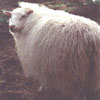

|
| Grey | This is a confusing name unless you think of this pattern as being named White Undercoat. This pattern gene produces an animal with a white undercoat (thel) while at the same time allowing the outer coat fibers (tog) to remain the base color (black or brown). This animal will be either a black grey or a brown grey (also called grey moorit). As animals age, this pattern diminishes the color. In the sheered examples, notice the white undercoat showing in the ruff around their faces and also the "sugar lips". |
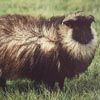


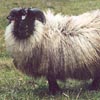

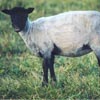
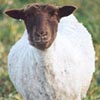
|
| Badgerface | This pattern causes areas on the back, sides, neck, face, and outer ears to be a light tan or white color. The markings on the face make the animal look like a badger. The basic color ( black or brown ) shows on the face, neck, belly and under the tail categorizing it as a black badgerface or a moorit (brown) badgerface. |
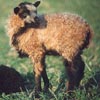

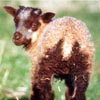
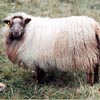
|
| Mouflon | Because this pattern is the opposite or reverse of the badgerface pattern, it causes areas on the face, inner ears, chin under neck, belly, and under tail to be light tan or white. The base color (black or brown) shows on the main body thereby producing a black mouflon or a brown (moorit) mouflon. |
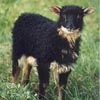
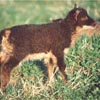
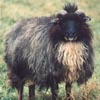
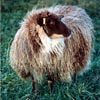
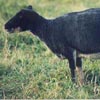


|
| Solid | This pattern should also be named No Pattern, as it does not modify the base color of the wool in any way. Therefore, the sheep will have a solid black or solid brown fleece. (two copies of this gene are required to produce a solid animal.) |

|
| Grey Mouflon | This is a single gene that produces a pattern that looks like the two patterns grey/mouflon in combination. However this is a completely different gene from an animal that inherits the 2 separate pattern genes for grey and mouflon from its parents. It is recessive to white and dominant to all other pattern genes. At this time the grey mouflon pattern (as a single gene) exists in sheep only in Iceland. The undercoat is white as in a grey and with the white mouflon markings. |
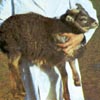
|
Possible Pattern Combinations
Since each sheep inherits only two of these six pattern genes these are some of the possible combinations. the ones in red are dominant and therefore visible to the eye. The ones in green are recessive and therefore not seen even though the animal carries this gene.
| Parent #1 | Parent #2 | Combination Outcome |
|---|---|---|
| badgerface | mouflon | Since both patterns are equally dominant they will both show at the same time making this animal badgerface mouflon. |
| badger | solid | This animals appears visually as a Badgerface even though it is carrying solid also. |
| mouflon | solid | This animals appears visually as a Mouflon even though it is carrying solid also. |
| white | badgerface | This animals appears visually as a white even though it is carrying badgerface also. |
| white | mouflon | This animals appears visually as a white even though it is carrying mouflon also. |
| white | solid | This animals appears visually as a white even though it is carrying solid also. |
| grey | badgerface | Since both patterns are equally dominant they will both show at the same time making this animal grey badgerface |
| grey | mouflon | Since both patterns are equally dominant they will both show at the same time making this animal grey mouflon. |
| grey | solid | This animals appears visually as a greyeven though it is carrying solid also. |
| white | grey | This animal will appear white even though it is carrying grey |
| white | white | White (homozygous for pattern) |
| grey | grey | Grey (homozygous for pattern) |
| badger | badger | Badgerface (homozygous for pattern) |
| mouflon | mouflon | Mouflon (homozygous for pattern) |
| solid | solid | Solid (homozygous for pattern) |
Factor S — The Spotting Gene
In actuality there is not a "no spotting" gene as this spotting works as in on/off basis. But for simplification of explanation I have described it here as a separate gene.
All Icelandic sheep carry two genes for this factor, inheriting one from each parent. There are only two choices here: Spotting or No Spotting. When and animal carries two genes for spotting then it will have random white spotting anywhere on its body and fleece. While this spotting does not cause rigid pattern like the pattern gene, spotting does tend to be passed on in generalized areas. In other words an animal that shows a spot on its forehead will sometimes pass a similar kind of forehead spot to its spotted offspring. There are 92 recognized numbered and named white markings catalogued by Stefan Adalsteinsson who did the studies on color genetics in Icelandic sheep. And some of them are called for example "Hood and cloak", "Jacob's markings", "Eagle head", "Stockings", "Blaze", "White collar with stockings", "Dark eye ring", and "Drops".
| Parent #1 | Parent #2 | Combination Outcome |
|---|---|---|
| Spotting | Spotting | This animal will be white spotted and is homozygous for the spotting factor. |
| Spotting | No Spotting | This animal will not show spotting even though it is carrying one spotting gene and is heterozygous for spotting. |
| No Spotting | No Spotting | This animal will not be spotted and is homozygous for spotting. |
The images below are some examples of spotted and non-spotted sheep (click on an image, or hover your mouse over it, for a description).

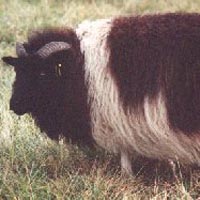
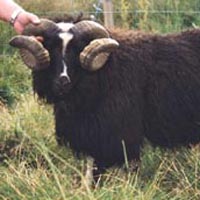
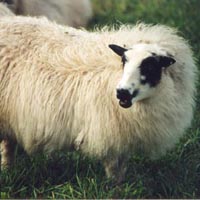

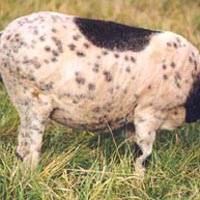
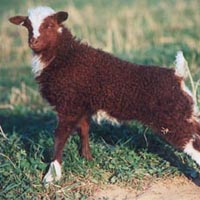

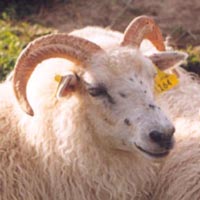
Phaeomelanin Factor
While not described in depth here there is one other minor gene that does cause some color in the fleece, face and legs. This gene allows the wool follicle to produce a pigment called Phaeomelanin which has been described as tan, yellow or sometimes red. It is seen most frequently on the head, legs and tail of white sheep. It is also seen in the light parts of the fleece of a badgerface. When present it gives the fleece a cream or light tan appearance. If there is a lot of this Phaeomelanin pigmented fiber in the fleece, it looks pinkish beige when wet. Lambs born with an abundance of this red fiber look rusty color at birth, however the pigment fades with age in the fleece. The head and leg continue to exhibit the red color. Phaeomelanin color can be turned off by the spotting gene. In other words white spotting will turn off the red color.
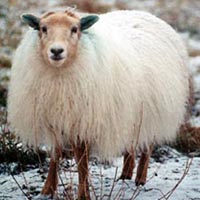
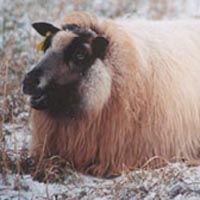

Gene Dominance
Overview
When there are two different genes in the genetics makeup, the dominant one will be the one that will be expressed ( seen ). It will mask, nullify or cover up the effects of the recessive ( non dominant ) gene. This also means that in order for you to see the effects of a recessive gene ( for color, pattern or spotting ) both inherited genes must be recessive.
The basic color gene (B loci)
The black color gene is dominant. The moorit (brown) color gene is recessive. For example if an animal carries one black and one moorit gene the sheep will have a black fleece because the black gene dominates the moorit one. This also means that if and animal has a brown fleece than you know that both of its color genes are the recessive moorit.
The pattern gene (A loci)
The order of dominance for the pattern gene is as follows:
| Order | Pattern | Notes |
|---|---|---|
| 1. | White | White is dominant over all other patterns. This means that when a lamb is carrying even one white pattern gene, than the fleece of that animal will be totally white, no matter what other pattern that lamb may also be carrying. |
| 2. | Gray-mouflan | This is a single gene pattern . This pattern is different than an animal that is carrying one pattern each of mouflon and grey. This is a rare pattern that is only found in Iceland at this time. This pattern is recessive to white and dominant to all other patterns (except white). |
| 3. | Grey, Badgerface & Mouflon |
These three pattern genes are all equally mid-dominant. None of the three can mask or cancel each other. This means that if an animal is carrying two of these genes both patterns will show at the same time. For instance, you can have a gray badgerface, or a badgerface mouflon or a gray mouflon sheep. The light area of one pattern will mask the colored area of the other pattern. A badgerface/mouflon for example will show very little color. They are at the same time recessive to the white and are dominant over the solid pattern. The following is a black-gray-badgerface lamb. Because the gray and badgerface pattern are equally dominant neither will cancel the other and both will show at the same time giving it a ghost like appearance. Notice the red Phaeomelanin on his legs also.
The following is a black-gray-badgerface lamb. Because the gray and badgerface pattern are equally dominant neither will cancel the other and both will show at the same time giving it a ghost like appearance. Notice the red Phaeomelanin on his legs also.
|
| 4. | Solid | This pattern ( or lack of a pattern ) is recessive to all of the other patterns. For example if the lamb shows a solid color fleece then it is carrying two recessive for the solid pattern. If it had inherited one solid gene and one gray gene its fleece would be gray as gray dominates solid. |
The spotting gene (S loci)
'No spotting' is dominant is over the gene for 'spotting'. Therefore in order to have a lamb with a spotted fleece the animal would need to be carrying two spotting genes.
The only animal whose complete gene chart you can be sure of just by looking at the animal visually, is a spotted moorit...
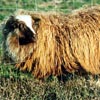
| Factor | Parent #1 | Parent #2 |
|---|---|---|
| Factor B — Basic Color Gene | Moorit | Moorit |
| Factor A — Pattern Gene | Solid | Solid |
| Factor S — Spotting Gene | Spotting | Spotting |
Other Color Observations
- Some solid colored animals "silver" with age while the fleece of others stay dark. It is assumed that there is a gene that is responsible for this. The silvering is in the outer coat (tog) only. The undercoat will remain black.
- White animals that are also homozygous for the spotting gene and therefore are "showing" spotting can usually be detected because their fleece will be a super white-white color.
- Gray lambs usually look all black or all brown when they are born. However they may have white hairs on their muzzle head or ears that tells you that they will eventually be gray. By one month of age the white undercoat is visible and growing in. This pattern is highly variable.
- Moorit lambs look almost black when they are born but can usually be determined to be a moorit because they have orange eye lid edges. By one month of age the color will lighten and you can tell that they are brown.
- Sheep that carry both the badgerface and mouflon pattern at the same time will show only a subtle dark line where the two patterns meet, usually on the rear leg and buttocks. They will be a light tan color everywhere else.
- Icelandic fleeces are each a little bit different in color and texture....
- The whites can range in hue from a very white-white through cream and into tan.
- The blacks can range from a blue black, into inky black or brown black.
- The moorits can range from a pale beige, taffy, milk chocolate, chestnut, dark chocolate and brown black.
- The badgerface can range widely in their fleece color depending on how much red and black fibers they have in their coats. The color can be buff, champagne or oatmeal. In addition many have a silver or gray base to each lock.
- The black grays range from blue gray, lilac, medium silver, and dark gray as well as the brown grays (gray moorit) that range from an apricot through a dark gray brown with white or light undercoat. Many of these two toned fleeces provide a true tweed yarn.